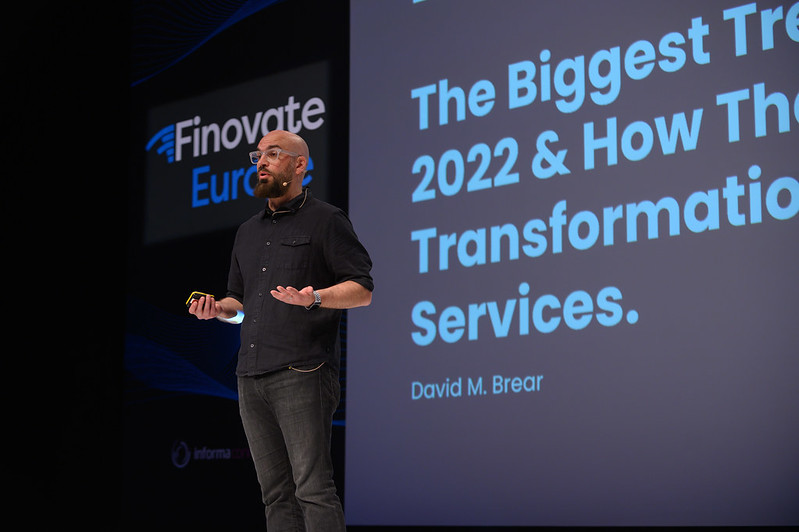
FinovateEurope 2022 is a wrap. Our first European fintech conference in what we all hope is truly the post-pandemic era was an excellent opportunity for Finovate veterans and newcomers alike to meet and share insights on the most critical issues in fintech today.
In many ways, the two keynotes that began each day of our two-day event served as reminders of both the accomplishments of fintech to date, as well as the challenges that innovators in fintech and financial services will face going forward.
From commodity products to intelligent services
In his keynote address on how fintech trends in 2022 will drive transformation in financial services, David Brear contextualized his remarks by describing the journey financial services has traveled from analog through digitization en route to becoming truly digital. CEO and co-founder of fintech consultancy 11:FS, Brear underscored the notion that this journey was defined by the evolution of financial services from “commodity products to intelligent services.” He suggested that many companies in financial services were still essentially bringing digital tools to enhance analog solutions – not unlike attaching a carriage to a Clydesdale. As such, he sees the transition toward truly digital banking as “only 1% finished” with plenty of room to go.

For Brear, the current moment is one of execution rather than ideas. Entrepreneurs and companies in financial services have a better idea than ever of what their customers want, and now is the time for firms in this space to ambitiously act to meet those needs. Interestingly, and foreshadowing the themes of the next day’s keynote from AI scientist Inma Martinez, Brear observed that fulfilling these needs will help banks and financial services companies gain or regain the kind of intimate, personalized relationships that are more reminiscent of the kind of connections that smaller, more community-based versions of these institutions historically have enjoyed with their customers and members.
Solving complexity to better serve humanity
Creating an appropriate role for artificial intelligence (AI) was the topic of our Day Two keynote address – How To Use Data Analytics & AI To Create Human Centric Financial Products – from AI scientist Inma Martinez. As someone with decades of experience with artificial intelligence, Martinez has a healthy respect for the capacity of AI to do things that human beings cannot. At the same time, however, Martinez insists that these capacities need to be harnessed in a way that enables AI’s complexity-solving abilities to respond to human needs for “safety, enjoyment, and purpose.” Reminding her audience that the world is not merely “computational,” Martinez said that AI needs to be imbued with EQ, or emotional intelligence, that prioritizes rather than simply includes the role of human cognition. This would support an evolution in design thinking from the basic objectives of “usability, functionality, and convenience” to the more satisfying, emotional, and human-centered goals of being “memorable, assuring, and wholesome.”

Martinez also emphasized the importance of a modern approach to data and data management called the data mesh. This concept calls for leveraging distributed architecture to give end users the ability to readily access and query data where it lives rather than having to deal with a singular, centralized location such as a data lake. Improving the ability to access data is critical, Martinez explained, in a world in which data is both the key to a deeper, more meaningful understanding of customer behavior and the primary source of insights that can streamline the process of creating and innovating new products and services.